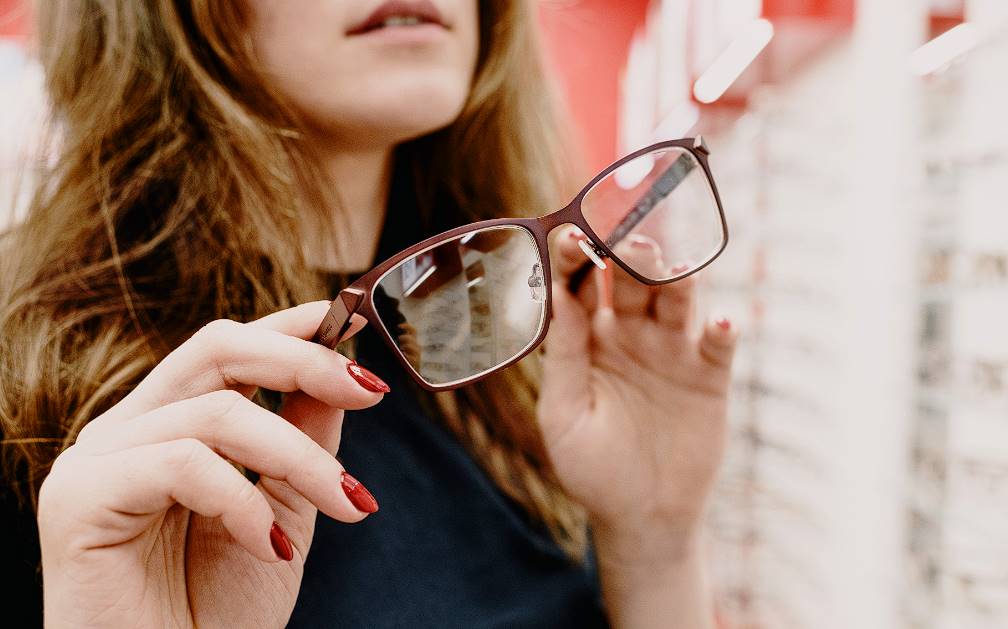The lenses of our eyeglasses are a major factor in the quality of our vision. The quality of our eyewear is heavily dependent on the lens material we select. Lens materials for eyeglasses have evolved as technology has progressed, and now there are many options available.
In this piece, we'll take a look at the various options available for eyeglass lenses. We'll go into detail about each type of lens material, outlining the pros and cons of each to help you make an educated choice.
Lens materials vary greatly in terms of weight, durability, optical clarity, impact resistance, and cost, therefore it's important to learn about these differences. By learning about your lens material possibilities, you'll be able to select the pair that best fits your needs.
Whether you're in the market for corrective or fashionable eyewear, arming yourself with knowledge regarding lens materials can help you make the best decision. So, let's explore the varied options for eyeglass lenses and learn what sets each type apart.
Glass Lenses
Glass lenses have been used in glasses for a long time and were originally the most popular choice. As lens technology has improved, however, glass lenses have lost some of their lustre. However, it is necessary to learn about their features and functions.
Glass lenses are crafted from optical glass that has been developed for use in eyewear. Glass lenses have superior optical clarity, which is one of their main benefits. They provide exceptionally high optical acuity, guaranteeing crisp and clear images. The reason for this is that glass has a relatively high refractive index, making it ideal for transmitting light without severe distortion.
Glass lenses are also more resistant to scratches than plastic ones. Lenses made of glass are more durable against scratches than those made of plastic or other soft materials. Lenses with this level of scratch resistance will last longer because they won't lose their clarity or visual performance over time.
However, glass lenses can have some drawbacks. Their heaviness is a major negative. Lenses made of glass are typically heavier than those made of other materials, which might lead to discomfort over time. The lenses' that can cause wrinkles and creases in the skin of the nose and cheeks.
Glass lenses are also more prone to breakage than other lens materials. They shatter easily if dropped or subjected to a strong enough force. This vulnerability raises safety concerns, especially in situations when there is a greater chance of lens breaking.
Glass lenses tend to be heavy and breakable, making them unsuitable for some sports and those who need lightweight eyewear.
Glass lenses, in conclusion, provide superior optical clarity and scratch resistance, guaranteeing sharp, clear vision. Their low durability and high weight make them less common than other lens materials.
Plastic Lenses
Lenses made of plastic, often known as organic lenses, have exploded in popularity in the eyewear market for a number of reasons.
CR-39, a type of polymer material developed from the lightweight plastic allyl diglycol carbonate, is the material of choice for most plastic lenses. This material has been developed to provide the best possible vision correction, and it also has a number of other advantages for the user.
Plastic lenses are prefered for several reasons, but their portability is a major perk. Plastic lenses are much more pleasant to wear for long periods of time than their heavier glass counterparts. The lighter frame puts less pressure on the wearer's face and nose, making them more comfortable to use.
Plastic lenses naturally resist damage from drops. They're safer than regular glasses since they won't splinter or crack when dropped, making them ideal for athletes and other physically active people. Plastic lenses are more long-lasting than glass ones since they can endure minor accidents and mishaps without breaking.
In addition, plastic lenses are usually cheaper than other lens materials, making them a more wallet-friendly choice for those shopping for inexpensive eyewear. Because of this inexpensive cost, more people can benefit from vision correction without sacrificing quality.
There are a few negatives to plastic lenses, though. Their vulnerability to scratching is a major drawback. Plastic lenses, in contrast to glass lenses, are more prone to surface scratches, which can diminish vision over time. To address this problem, several anti-scratch coatings can be added to plastic lenses to make them more resilient to scratches.
Another thing to keep in mind is that plastic lenses might not have as good optical clarity as glass ones. While plastic lenses are effective for most people, especially at higher prescription powers, some people may observe minor distortions or aberrations.
In conclusion, many people who wear eyeglasses choose plastic lenses because of their light weight, comfort, impact resistance, and low cost. Coatings and improvements in manufacturing have helped plastic lenses become more scratch-resistant and durable without sacrificing optical clarity.
Polycarbonate Lenses
Polycarbonate lenses are a popular option because of their many advantages. Let's take a categorical look at the features of polycarbonate lenses:
Material Characteristics
- Polycarbonate is a thermoplastic material that is used to create polycarbonate lenses.
- Polycarbonate is an extremely long-lasting material, unbreakable even when subjected to extreme forces.
- In comparison to glass or plastic lenses, it is much more portable.
- The lenses in polycarbonate eyewear are renowned for their resilience and pliability.
Advantages
- Impact Resistance: Polycarbonate lenses are highly impact-resistant, making them ideal for individuals who engage in sports or have an active lifestyle. They provide a higher level of eye protection compared to other lens materials.
- Thin and Lightweight: The lightweight nature of polycarbonate lenses enhances comfort, especially for individuals who require strong prescriptions or have sensitivity to heavy eyewear.
- UV Protection: Polycarbonate lenses inherently provide UV protection, blocking harmful UVA and UVB rays. This feature helps safeguard the eyes from the damaging effects of prolonged sun exposure.
- Safety: Due to their impact resistance, polycarbonate lenses are often used in safety glasses, protecting the eyes from potential hazards in various occupational and industrial settings.
- Eye Protection: Polycarbonate lenses offer a higher level of safety by reducing the risk of eye injuries from accidental impact, flying debris, or projectiles.
Disadvantages
- While polycarbonate lenses correct vision well, their optical clarity may be compromised in comparison to that of glass. Polycarbonate lenses used to have poor optical quality, but modern production methods have greatly enhanced their clarity.
- Polycarbonate lenses are susceptible to scratches and should be treated with care to preserve their clarity. Scratch-proof coatings are a viable solution to this problem.
Prescription Suitability
- Polycarbonate lenses can correct significant levels of refractive error and are therefore useful for a wide variety of prescriptions.
- They are able to efficiently treat myopia, hyperopia, and astigmatism.
In a nutshell, polycarbonate lenses excel in the areas of impact resistance, lightweight comfort, ultraviolet (UV) protection, and safety. Their decreased optical clarity and need for scratch prevention are minor drawbacks compared to their popularity among those wanting strong and protective eyewear.
How To Choose the Type of Lens
A person's visual comfort and level of contentment with their eyewear can be significantly affected by the choice of lens material. The choice of lens will depend on the following factors:
Prescription
Your prescription is the primary factor to think about. The thickness or thinness of your lenses depends on the refractive index of the lens material you choose. Thinner lenses may be necessary for higher prescriptions to avoid an unattractive appearance. To find out which lens materials are appropriate for your prescription, you should go to an eye doctor.
Lifestyle and Activities
Think about the things you do on a regular basis and how your lifestyle impacts you. Lenses with impact protection, like polycarbonate or Trivex, are a good option if you lead an active lifestyle or participate in sports. However, if you lead a less active lifestyle, you may have greater leeway in selecting the lens material that best suits your needs.
Comfort
When it comes to eyewear, comfort is paramount. Think about how the lens material feels when worn for long periods of time, especially its weight. High-index lenses, plastic frames, and polycarbonate lenses are all lightweight options for eyeglasses.
Visual Clarity
Clarity to the eye is also crucial. All lens materials correct vision, but there may be slight variations in sharpness depending on the material. Traditionally, glass lenses have provided the best optical clarity, but recent innovations have raised the bar for other materials like plastic and polycarbonate. Make sure your lens material of choice provides adequate visual clarity for your unique needs by consulting with your eye care provider.
Budget
The price tag is a major consideration for many people. Glass lenses tend to be more expensive than their plastic, polycarbonate, or Trivex counterparts. There may also be a price premium for high-index lenses. Make a plan and talk to your eye doctor about low-cost solutions.
Special Considerations
Talk to your eye doctor about any special needs or worries you may have. You may want to consider getting lenses with built-in UV protection if you spend a lot of time outside, for instance. High-index materials may be an option if you need a strong prescription filled or want smaller lenses.
Always remember to get a professional opinion from an optician who can evaluate your eyes and prescribe the best lens material for your prescription, lifestyle, and personal preferences. They'll be able to help you choose the best eyewear for your needs and lifestyle so that you may enjoy the best possible vision and comfort.
Which Is Better Glass or Plastic Lenses
The optical clarity of glass lenses is typically superior to that of plastic ones. Because of their greater refractive index, they improve visual clarity. However, technological advances have greatly enhanced the optical quality of plastic lenses, and many people now find that plastic lenses are clear enough for their purposes.
Plastic lenses are far more portable than their glass counterparts. Plastic lenses may be the best option if you need to wear your glasses for long periods of time because of how light they are.
When dropped, glass lenses shatter, but plastic lenses absorb the force of the impact and remain intact. Plastic lenses, especially polycarbonate or Trivex, may offer improved safety and durability if you lead an active lifestyle, play sports, or work in areas where eye protection is vital.
Thinner lenses can be made for stronger prescriptions when using glass lenses due to their higher refractive index. Glass lenses could be a good choice if you have a high prescription but are concerned about lens thickness. High-index plastic lenses, however, can be used as a lightweight and thin substitute for glass lenses.
When opposed to plastic lenses, glass ones are much more resilient to scratches. They're less likely to get scratches on the outside, which can detract from the sharpness of your view. Plastic lenses, on the other hand, can have scratch-resistant coatings applied to them to make them last longer and prevent scratches from occuring as often.
In comparison to glass lenses, plastic ones tend to be less expensive. The manufacturing process and optical qualities of glass lenses make them more expensive. Plastic lenses can be a more affordable option if price is a major consideration.
Your needs, lifestyle, and personal preferences will determine whether glass or plastic lenses are the preferable alternative. Make the best choice for your prescription, visual needs, and wallet by consulting with an eye care specialist or optician. They'll be able to help you find the lens material that suits your needs in terms of clarity of vision, ease of wear, and longevity.
Conclusion
Thanks to technological advancements, numerous lens materials for eyeglasses are now commercially available. Glass lenses are made from special optical glass engineered for use in eyewear. They are scratch-resistant, feature a high optical clarity index, and a sharp focus. Their heaviness, which can lead to lines and creases in the skin around the nose and cheeks, is a big downside, though. Glasses with metal lenses have been around for a while, but they've lost some of their shine over the years.
Lenses made of metal are scratch-resistant, have a high optical clarity, and provide sharp vision. The weight of these items, however, can cause irritation and premature ageing of the skin around the nose and cheeks. Some sports and people who like lightweight eyewear rule out glasses with glass lenses since they are so easily broken. The widespread adoption of plastic lenses can be attributed to their light weight, durability, and low cost. However, they are not as strong as glass lenses and can easily be scratched.
Lenses made of plastic can have an anti-scratch coating applied to them to make them scratch-resistant. Polycarbonate lenses are widely used in eyeglasses because they are lightweight, flexible, impact-resistant, and inexpensive. Polycarbonate lenses offer superior protection from the sun's harmful rays, are lightweight and thin, and are impact resistant. Poor optical clarity, scratch-resistant coatings, and incompatibility with prescription lenses are all drawbacks. In addition to being suitable for a wide range of prescriptions, polycarbonate lenses are capable of correcting high degrees of refractive error.
Plastic lenses have a longer lifespan and are easier to transport. While glass lenses naturally resist scratches better than plastic lenses, the latter can be treated with a scratch-resistant coating to extend their useful life. If you're on a tight budget, plastic lenses may be a better choice. If you need help deciding, talk to an eye doctor or optician.
Content Summary
- The lenses of our eyeglasses are a major factor in the quality of our vision.
- The quality of our eyewear is heavily dependent on the lens material we select.
- Lens materials for eyeglasses have evolved as technology has progressed, and now there are many options available.
- Lens materials vary greatly in terms of weight, durability, optical clarity, impact resistance, and cost, therefore it's important to learn about these differences.
- By learning about your lens material possibilities, you'll be able to select the pair that best fits your needs.
- Whether you're in the market for corrective or fashionable eyewear, arming yourself with knowledge regarding lens materials can help you make the best decision.
- However, it is necessary to learn about their features and functions.
- Glass lenses are also more prone to breakage than other lens materials.
- This vulnerability raises safety concerns, especially in situations when there is a greater chance of lens breaking.
- Glass lenses tend to be heavy and breakable, making them unsuitable for some sports and those who need lightweight eyewear.
- Glass lenses provide superior optical clarity and scratch resistance, guaranteeing sharp, clear vision.
- Their low durability and high weight make them less common than other lens materials.
- Lenses made of plastic, often known as organic lenses, have exploded in popularity in the eyewear market for a number of reasons.
- There are a few negatives to plastic lenses, though.
- Their vulnerability to scratching is a major drawback.
- Plastic lenses, in contrast to glass lenses, are more prone to surface scratches, which can diminish vision over time.
- To address this problem, several anti-scratch coatings can be added to plastic lenses to make them more resilient to scratches.
- In conclusion, many people who wear eyeglasses choose plastic lenses because of their light weight, comfort, impact resistance, and low cost.
- Coatings and improvements in manufacturing have helped plastic lenses become more scratch-resistant and durable without sacrificing optical clarity.
- Polycarbonate Lenses Polycarbonate lenses are a popular option because of their many advantages.
- In comparison to glass or plastic lenses, it is much more portable.
- The lenses in polycarbonate eyewear are renowned for their resilience and pliability.
- Due to their impact resistance, polycarbonate lenses are often used in safety glasses, protecting the eyes from potential hazards in various occupational and industrial settings.
- While polycarbonate lenses correct vision well, their optical clarity may be compromised in comparison to that of glass.
- Polycarbonate lenses can correct significant levels of refractive error and are therefore useful for a wide variety of prescriptions.
- In a nutshell, polycarbonate lenses excel in the areas of impact resistance, lightweight comfort, ultraviolet (UV) protection, and safety.
- A person's visual comfort and level of contentment with their eyewear can be significantly affected by the choice of lens material.
- Your prescription is the primary factor to think about.
- The thickness or thinness of your lenses depends on the refractive index of the lens material you choose.
- To find out which lens materials are appropriate for your prescription, you should go to an eye doctor.
- Lenses with impact protection, like polycarbonate or Trivex, are a good option if you lead an active lifestyle or participate in sports.
- When it comes to eyewear, comfort is paramount.
- Think about how the lens material feels when worn for long periods of time, especially its weight.
- High-index lenses, plastic frames, and polycarbonate lenses are all lightweight options for eyeglasses.
- Make sure your lens material of choice provides adequate visual clarity for your unique needs by consulting with your eye care provider.
- Make a plan and talk to your eye doctor about low-cost solutions.
- Always remember to get a professional opinion from an optician who can evaluate your eyes and prescribe the best lens material for your prescription, lifestyle, and personal preferences.
- They'll be able to help you choose the best eyewear for your needs and lifestyle so that you may enjoy the best possible vision and comfort.
- The optical clarity of glass lenses is typically superior to that of plastic ones.
- Plastic lenses may be the best option if you need to wear your glasses for long periods of time because of how light they are.
- When opposed to plastic lenses, glass ones are much more resilient to scratches.
- In comparison to glass lenses, plastic ones tend to be less expensive.
- The manufacturing process and optical qualities of glass lenses make them more expensive.
- Plastic lenses can be a more affordable option if price is a major consideration.
- Your needs, lifestyle, and personal preferences will determine whether glass or plastic lenses are the preferable alternative.
- Make the best choice for your prescription, visual needs, and wallet by consulting with an eye care specialist or optician.
Frequently Asked Questions
Polycarbonate lenses are a great choice for safety glasses because they provide 100% UV protection, are lightweight, and are impact resistant. They're great for people who lead active lives or who need tough eyewear.
Historically, glass lenses have provided the clearest vision, but recent innovations have dramatically enhanced the optical quality of plastic lenses. Plastic lenses are often considered clear and effective in correcting vision.
Thinner lenses for stronger prescriptions can be made using glass lenses because of their higher refractive index. High-index plastic lenses, however, provide an alternative to glass that is both lighter and thinner.
Scratches are more common on plastic lenses than glass ones. Scratch-resistant coatings, however, can greatly improve the lifetime of plastic lenses and reduce the likelihood of scratches.
In general, glass lenses are more expensive than plastic ones. Glass is more expensive than other materials because of its high manufacturing cost and unique optical characteristics. Plastic lenses, on the other hand, may be purchased for less money, making them a more accessible option for many people.









